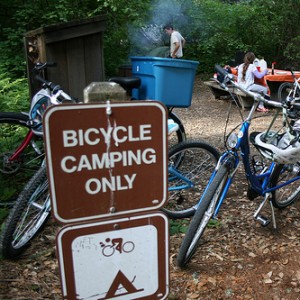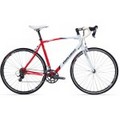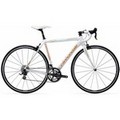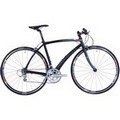 Bicyclist choose bicycle camping for many reasons. For me, traveling on a bicycle is an adventure and sometimes quite unpredictable.
Bicyclist choose bicycle camping for many reasons. For me, traveling on a bicycle is an adventure and sometimes quite unpredictable.
So the ability to camp between hotel or hostel stays allows me to go where I want and when I want. I am not tied to a certain mileage or destination to reach the next available room.
And the economic benefits can be quite appealing.
What You Need to Know About Bicycle Camping
Where To Camp Stealth Camping How To Carry Everything
What To Wear How To Select Your Gear What Gear To Take
Very seldom have I planned on bicycle camping every night that I was on the road; unless the trip was mainly a mountain biking adventure where camping was my only alternative. It is not that I prefer hotels (the quite opposite), but it is nice to have a comfortable bed, hot shower, and warm, dry roof over my head on occasion. It also allows me time to catch up on what is happening in the world.
A few years ago, I went on an extended trip where I didn’t have contact with any media, radio, or television for about five weeks. It was a dream come true to not hear about stressful world events. During that trip, I learned that only three things matter to me when I was on the road, trail, or on an ocean crossing: What the weather is going to be like that day; where I am going for the day; and when, where, and what I am going to eat. Nothing else seemed to matter or it never crossed my mind. If it didn’t affect me or my day, it wasn’t important. It was wonderful. When the day came that I stayed in a hotel, I watched a little television and I felt completely disconnected from the world until I caught up on daily events.
Bicycle camping allows me to remember those weeks when world events didn’t matter. All the virtues of escaping from a fast pace world that we all know too intimately can be experienced while camping. So instead of driving yourself to put in the miles just to make it to your next hotel, just relax, enjoy the scenery, and don’t squander the opportunity to become truly self-sufficient.
How To Select Your Gear
Buy lightweight and quality gear and it will last for years. Lower quality tents and sleeping bags from discount stores may be alright for car camping and short trips. I don’t recommend them for bicycle camping. A quality tent and rainfly should average about 2 to 3.5 lbs. per person. That means two people can share the load for a 2-person tent that weighs a total of 4 to 6 lbs. and still carry a reasonable weight each.
Expensive four-season expedition tents are definitely overkill for most bicycle camping.
Sometimes just a tarp, bug tent and groundcloth can suffice. For an in depth discussion for tent selection, please read this page.
Lightweight “mummy” style or tapered rectangular sleeping bags should be your choice for bicycling. A high-quality synthetic “mummy” bag for summer or three-seasons (25 or 35°F and above) should weigh between 2 to 3.5 lbs. A similar down bag should be about 1 lb. lighter for the same temperature range. Again, you should stay away from the discount store “sleepover” or “car camping” type of bags. They are heavy and won’t last for more than a few long camping trips. To read more above sleeping bag selection, please read this page.
If you plan on cooking your own meals, I recommend you purchase a multi-fuel stove designed for ultra-lightweight backpacking. The same goes for cooking pots and pans: buy durable and lightweight items and try to share if you are not going to be alone. For more information about stoves suitable for bicycle camping, please read this page.
- I’d highly recommend any MSR stoves & cookware
 , as I’ve found them to be the most durable, they cook super fast, and are reliable for years.
, as I’ve found them to be the most durable, they cook super fast, and are reliable for years.
What to Wear
I divide my bicycle touring attire into three categories: cycling clothes, off-the-bike clothes, and cold/wet weather gear. For a discussion for clothing selection for touring, please go to this page.
Since I may be bicycle camping significantly during a tour, access to laundry facilities can be days apart. That is why I have carry a separate set of off-the-bike clothes and 3 to 4 pairs of cycling clothes. One clean and dry pair I will have on during the day, one dry pair in the pannier, and one dirty or just cleaned pair in the pannier. This keeps me from wearing dirty cycling shorts, which may cause chafing and infection. Normally I go 2 or 3 days between during my laundry. Always after I clean up in the evening, I will put on a clean and dry set of clothes.
I have a few rules of the road that I follow:
- I prefer synthetic underwear
 , cycling shorts
, cycling shorts , socks and shirts due to quick drying.
, socks and shirts due to quick drying. - I always keep a pair of shorts or pants quickly available to slip on if I go in a restaurant or somewhere that tight cycling shorts may be inappropriate.
- I prefer brightly colored shirts and jackets for better visibility on the road.
- My cleated cycling shoes are practical for long hours on the pedals and short walks without the cleats interfering.
- I carry a pair of sandals and/or athletic shoes for long walks and after cycling hours.
What Gear To Take
The following is a list of gear that I take on an extended tour. I remove gear or add more depending on the weather conditions expected, length of tour, and destination. If I am only bicycle camping in an emergency and I don’t plan on cooking, then the sleeping and cooking gear may be reduced drastically. But the following is a good place to start when planning a bicycle camping tour.
Bicycling Clothes
- 3 nylon or lycra short sleeve tops
- 3 pairs of padded lycra cycling shorts
- 4 pairs of synthetic (quick dry) socks
- Cycling gloves
- Sunglasses
- Nylon wind vest
- Arm warmers
- Cycling shoes
Cold/Wet Weather Clothes
- Fleece jacket
- Face/ear warmer
- Leg warmers
- Waterproof or highly water-resistant rain jacket
- Rain pants
- Full finger gloves
- Toe covers
After Biking Clothes
- 1 or 2 tee shirts
- 1 long sleeve shirt or pullover
- Lightweight sandals and/or athletic shoes
- Zip-off leg pants/shorts
- Swimming suit
- 2 pairs of underpants
Sleeping Gear
- Sleeping bag
- Self-inflating 3/4 length mattress
- Camp pillow
- Tent, stakes, poles
- Tarp
- Tent groundcloth/footprint
- 50 feet lightweight 1/4″ rope
Cooking Gear
- 2 or 3 quart cooking pot
- Frying pan/pot lid
- Fork/spoon set
- Sharp knife
- Small spatula
- Cup w/measurements on side
- Can opener
- Lightweight/foldable plate
- Gas stove/fuel bottle
- Water filter or tablets
- Pot scrub pad
- Small cleaning/drying cloth
- Fire starter kit/candle
- Camp soap
Tools
- Small screwdrivers (flat/phillips)
- Set of allen wrenches (7,8,9,10mm)
- Small adjustable wrench
- Set of cone wrenches
- Pliers/Leatherman multi-tool
- Chain tool
- Spoke tool
- Crank extractor
- Bottom bracket tool
- Rear cassette remover
- 3 tire irons
- Inner tube patch kit
- Tire pump
Spares
- 2 inner tubes
- Folded tire
- Lub for chain
- Extra spokes (1 front, 2 cassette rear, 1 rear)
- Brake cable
- Derailleur cable
- Necessary bolts and nuts
Personal Items
- Small scissors/clippers
- Small mirror
- Hair comb/brush
- Toothbrush/paste
- Shampoo
- Sun block
- Safety razor
- Needles/thread
- Lip balm
- Mid-size towel
- Wash cloth
- Small first aid kit
- Toilet paper
- Emergency change for phone
- Money/credit cards/travel checks
- Medical info/emergency contact/insurance
- Driver license/ID/passport
Miscellaneous
- 3 water bottles
- Bike lock/cable
- Flash light/bike light
- Rear red flashing light
- Spare bulbs/batteries
- GPS and batteries
- Maps
- Cell phone and charger
- Bike computer and spare battery
- Note pad/pencils
- Laptop computer and charger
- Camera/film
- Weather Radio
- Plastic bags (clothes/small items)
- Weather radio
- Foldable cloth bucket
- Lock for locker
Where to Camp
An argument can be made for “credit card” touring. Your bicycle will be lighter and you can travel so much faster. And your bicycle doesn’t have to be a dedicated touring bike. Most sport, road, and hybrid bicycles will handle moderate touring with minimum gear weight. This touring style works well in Eastern USA, West Coast USA, Europe, Great Britain, and Japan. The negative side of this argument, however, is spending the money, preselecting night stays, getting reservations in advance, and forcing yourself a mileage goal no matter the road problems. So for me, I prefer to camp as much as possible and stay in hotels or hostels occasionally.
If you are traveling in remote or rural areas, you may have no other choice but to camp. In many countries, including western North America, hotels and accommodations may be 100 miles or more apart. Hopefully, you can find a public or private campground. Unfortunately, most campgrounds are filled with mammoth RVs lined up like in a dealer’s lot and with TVs blaring from satellite programing and DVDs recorders. Unless you find a campground in a national or state forest, you may feel like your are in a noisy road side motel.
It seems like in America, camping is bringing your home comforts with you. And I have to mention all the campground and waterpark combinations that you may see. I have stayed at private campgrounds that charge almost as much as some motels. Even in Great Britain and Europe, group or caravan camping is quite popular, and some campgrounds can seem like amusement parks where people and groups stay for weeks at a time. Here too the price can be expensive.
There are exceptions though, and I have stayed in some wonderful places. Some campgrounds will have a small area dedicated for tent campers or just allow tents. A primitive campground can be a small area with a grill and table in the woods or just a farmers field with no trees or anything else. The latter are numerous in Great Britain and Europe. Normally, simple accommodations will reflect an inexpensive price. I suggest that you get a camping guide for your location and research the options thoroughly before setting out.
Stealth Camping
Another bicycle camping option is “stealth” or “free” camping. You find yourself in a rural or wilderness area with no recognized campground. In this case you have no alternative but to find a place to camp. First, I suggest that you ask around at local businesses, houses, and churches for ideas. You will be surprised how many people will let you pitch a tent in a church yard, their property, behind a building, or just run you off. If someone offers you a place, be kind and don’t start any fires, clean up completely, and leave without a trace. If you are told to get lost, again be very nice and just leave and get as far away as possible and quickly.
Sometimes you may find yourself with no other option but to “stealth” camp. Let me tell you that I am not advocating this style of bicycle camping, but many bicyclist have done it and still do it, including myself. I usually ride as late as possible, having eaten and collected water before stopping, and then look for a place out of sight. I prefer a a flat location, not too low in case of rain, that is well hidden from any houses, cars, people walking, or cars parking. I use the minimum camp set up: a small tent or a hammock with a tarp, no blaring stove, and a flashlight only in the tent and only when needed. I never camp off a side dirt road. Narrow, isolated roads can be popular for people parking and partying at night. You want to stay away. Be careful of private and national forest lands during hunting season.
How to Carry Everything
Bicycle camping requires a lot of gear that can add about 45 to 55 lbs. of weight to a 25 to 35 lb. touring or mountain bike. A quality bicycle made for that weight can handle the load with the proper rack and pannier system. Many bicyclist, however, prefer to pull a bicycle trailer and minimize the pannier capacity to just a handlebar bag. They would rather pull the weight instead of carry the weight. Both systems work. Which way should you go? For a discussion of bicycle trailers versus panniers, go to this page.
Since the additional equipment for bicycle camping adds a lot of weight to your bicycle. Consequently, for a safe and pleasant tour, you need to carefully consider the pannier configuration and rack capacity for your needs. I suggest that you read the pages for pannier configuration for bicycle camping and rack selection.




What about personal protection? I would recommend a small handgun chambered in 9mm. Pepper/bear spray won’t always work when dealing with threats, be it the 4 or 2 legged type. You have everything to take care of your bike, your sanitation, but nothing to keep you alive should you be attacked or come upon someone with other than the best intentions in mind for you.
Hi Mike,
A lot depends on where you are touring. Personally, pepper spray has been more than adequate for my experiences.
Uh, yeah, if you’re travelling in America. Or maybe Asia.
Other places on the other hand, just don’t allow you to carry a handgun at all. Canada and the UK, for example.
Very true, Ernie. Very true.
Hi Mike B,
If you’re doing your cycle touring in the UK I don’t recommend bring either a handgun or pepper spray – otherwise you might find yourself enjoying several free months of accommodation courtesy of Her Majesty’s Prison Service!
Otherwise a top article 🙂
Good point, Julie 🙂 Just FYI – It wasn’t Mike that wrote the article. John, one of our writers, wrote it.
Instead of PEPPER SPRAY, buy a can of WASP STOPPER when you arrive. It has a pretty long distance spray and will stop just about any animal/person with a shot to their eyes!
hi,
just deciding that I’d like to cycle the full pilgrims route from Canterbury to Santiago de compostela in Galicia. i have been camping for years, also done a fair bit of long distance walking and am a keen cyclist so interested in seeing how to ut them together, key thing – how much extra hassle is all the camping gear and what could you ditch if you were really stripping back?
Hey there I am so excited I found your webpage, I really found you by error, while I was browsing on Yahoo for something else,
Anyhow I am here now and would just like to say thanks a lot for a marvelous post and a all round thrilling blog (I also love the theme/design), I don’t
have time to read it all at the minute but I have bookmarked it and
also included your RSS feeds, so when I have time I will be back to read a lot more,
Please do keep up the fantastic work.
I have been surfing online more than 2hours today, yet I neveer found any interesting article like yours.
It’s pretty worth enough for me. Personally, if all website owners
and bloggers made good content as you did, the web will be
a lot ore uweful than ever before.
A very detailed gear list. Thanks. All of the talk was the handgun (which does seem weird to me) but I would love to hear if anyone is doing off road bike camping. I have a couple of spots I go to that require a mountain bike and solid trailer to get to the destination. Thanks for providing the resource.
You made some good points there. I checked on the
web for more info about the iswsue andd found most individuals will go along with
your views on this site.
You ought to take part in a contest for one of the greatest sites
on the net. I most certainly will recommend this site!